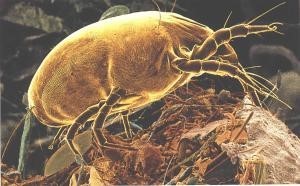Did you know that Dust Mites are the principle cause of asthma and allergies in our country?
What Are Dust Mites?

They can be seen under a microscope like as whitish bugs. Mites measures only about one-quarter to one-third of a millimeter. Their life cycle consist of several stages, from egg to adult. A female may lay as many one hundred eggs in her life time. There are at least 13 species of mites, all of which are well adapted to the environment inside your home. Depending on the species, it takes from 2 to 5 weeks for an adult mite to develop from an egg. Adult may live for 2 to 4 months.
Dust Mites lives in temperatures of 68 to 77 degrees Fahrenheit and require relative humidity levels of 70 % to 80% at least 50% of humidity to survive. Mites are not usually found in dry climates. They avoid the light, beds provide the warmth, darkness, high humidity, and shed skin scales that mites crave. A mattress may contain over a million dust mites.
What is Dust Mites Allergy?
Dust allergy is actually a sensitivity to substances in the waste particles and body fragments of house dust mites. High levels of exposure to dust mites are an important factor in the development of asthma in children. Household dust is not a single substance but rather a mixture of many materials. Dust may contain tiny fibers shed from different kinds of fabric, as well as tiny particles of feathers, dander from pet dogs or cats, bacteria, food, plant and insect parts, and mold and fungus spores. It also contains many microscopic mites and their waste products.
Allergy Symptoms:
Many people recognize allergy such as a runny or stuffy nose, itchy, watery eyes, and sneezing from dust exposure related to common household chores such as vacuuming, dusting and sweeping. House dust exposure can also trigger asthma symptoms for example wheezing, coughing, chest tightness and shortness of breath.
What causes the allergic reaction?
Allergies occur when our immune system reacts to a foreign substance such as pollen, pet dander or dust mites. Our immune system produces proteins known as antibodies. Those antibodies protect us from unwanted invaders that could make us sick or cause an infection. For example, antibodies react when we have contact with the waste particles that mites have produced, and the body fragments of dead dust mites, that become airborne, are inhaled and our immune system responds and produce this inflammatory response in our respiratory system.
Tips to reduce Mites allergies?
- The first and the most important step to reduce dust mites is to use a dehumidifier or air conditioner to maintain relative humidity at about 50% or bellow.
- The second is encase your mattress and pillows in zippered dust-proof covers.
- The next most important step is wash all bedding and blankets weekly in hot water at least 130-140 Fahrenheit to kill dust mites.
- Replace wool or feathered bedding with synthetic materials and traditional stuffed animals with washables ones.
- Use a damp mop or rag to remove dust. Never use a dry cloth.
- Wash rug in hot water whenever possible. Cold water leaves up to 10 percent of mites behind.
- Wear a mask while vacuuming to avoid inhaling allergens, and stay out of the vacuumed area for 20 minutes to allow any dust and allergens to settle after vacuuming.
- Windows should have roll-type shades instead of curtains, if you have curtains, be sure to wash them often.
- Use a high quality vacuum that entraps allergen and prevents it from blowing out through the exhaust.
It is probably impossible to avoid Dust Mites completely, but we can make some changes in our environment inside our home to help us and reduce the exposure of these tiny and unwanted “guests”.
Source: Mission Allergy; National Institute of Environ; Mayo Clinic.
If you suffer asthma or any allergies issues and you have not clean your carpet in a 6 months it is time for you to hire a professional cleaner. If you need any help please do not hesitate to contact us 502-365-6779.

